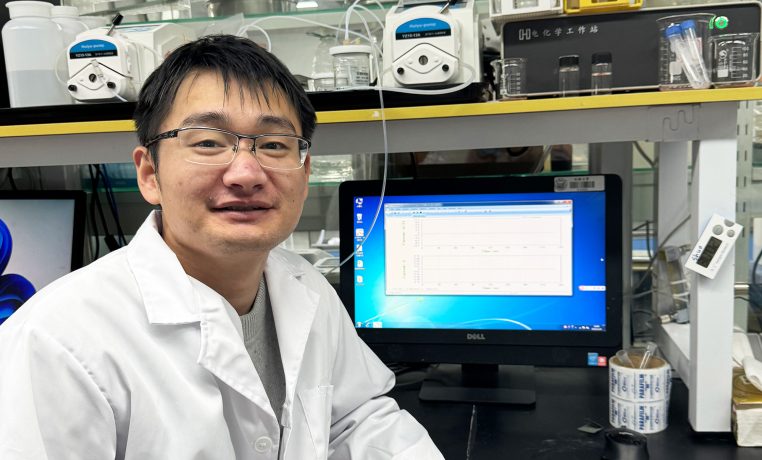A Novel Framework for Selective CO2 Adsorption in Complex Gas Mixtures
Professor at the College of Environmental Science and Engineering, Tongji University, China
Program-specific researcher with the Kitagawa Lab, at the time of this research
Yifan Gu
Yifan Gu
Dr Yifan Gu was a program-specific researcher working in iCeMS Susumu Kitagawa Lab before his current position at Tongji University, China. His research mainly focused on the interdisciplinary study of porous and environmental functional materials. He designed a series of new porous coordination polymers with high molecular recognition ability for gases allowing for energy efficient CO2 capture.

Please share with us the significance of your manuscript in terms of its research achievements, impact, or uniqueness.

CO2 is an important greenhouse gas and a major impurity requiring separation from various industrial gas mixtures. However, compared with other small gas molecules, the intermediate size and moderate physicochemical properties of CO2 make the design of sorbents with exclusive CO2 recognition performance extremely challenging, especially in multi-component gas systems. Porous coordination polymers (PCPs) are porous materials formed by metal ions or clusters coordinated with organic bridging ligands. By strategically choosing metal components and carefully adjusting the dimensions and structures of organic ligands, a wide range of crystalline substances can be synthesized. These substances are characterized by their porous nature, with pores featuring finely tuned sizes, configurations, and chemical affinity properties. Recent progress in this field has resulted in the development of PCPs with dynamic pore behaviors, which respond to the adsorption of specific molecular species.
In this study, we introduced an innovative, flexible PCP featuring a wavy channel framework designed for selective interaction and subsequent adsorption of CO2 molecules. This capability is achieved through engineered pore gates that exclusively allow CO2 molecules to pass through. Consequently, this groundbreaking material excels at capturing CO2 from diverse gas mixtures containing crucial industrial molecules like nitrogen, methane, carbon monoxide, oxygen, hydrogen, argon, ethane, ethylene, and acetylene. In addition to the framework's structural flexibility, which allows for the thermodynamic separation of specific gas molecules, this material's exceptional molecular discernment also stems from the dynamic regulation of diffusion kinetics at the channel gate. This strategic approach is expected to provide essential foundational insights for the design and development of porous materials specialized in high-efficiency separation processes within complex mixture systems.
Please tell us what was the most gratifying or inspiring moment for you during this research project.
The most inspiring moment in this research project was when I observed the unique adsorption behavior of the developed PCP. We tested the adsorption isotherms of our designed PCP for 10 different gases at different temperatures. The collected adsorption data exceeded 100 items. Finally, we confirmed that our designed PCP opens gates and adsorbs only carbon dioxide among various similar gas molecules. Before this moment, such interesting gas sorption selectivity had never been reported.
Please tell us about the biggest challenge or problem you experienced while conducting your research. How did you overcome it?
The biggest challenge was that we were unable to resolve the crystal structure of our designed PCP using single crystal diffraction analysis due to the small crystal size. To address this issue, we tried in-situ synchrotron powder X-ray diffraction analysis at SPring-8. To ensure high-quality data, we conducted numerous tests continuously, even overnight. Many thanks to Assoc Prof. Ken-ichi Otake for his invaluable support in analyzing the crystal structure of the gas adsorbed phase, finally, we obtained the crystal structure for further studying the adsorption mechanism.
Would you consider this work to be a turning point in your overall research direction? If so, how has your research direction changed as a result of this work?
Yes. In previous studies, we usually set some simple environmental conditions for material application research. However, in practical application scenarios, the performance of materials is often disturbed by multiple coexisting substances. Designing porous materials with ultrafine molecular recognition capabilities can to some extent address this challenge. In this work, we successfully achieved precise recognition of CO2 in various gas mixtures through material design and elucidated its mechanism. In future research, I will be committed to designing more “intelligent” porous environmental functional materials for real applications.
Please describe the current situation of your career. What is your current position? How has the knowledge and experience gained at iCeMS influencing your career?
I am currently working as a professor at the College of Environmental Science and Engineering, Tongji University, China. iCeMS is a world leading research institute. First, I learned how to conduct good research via deep cooperation with distinguished professors, great colleagues, skillful technicians, and powerful instruments. Second, the management procedures for laboratory operation in iCeMS had greatly inspired me. I believe that this experience will be very helpful as I start my own independent research work and begin building my own research group.
Finally, please give a message or advice to young iCeMS researchers.
Be patient with your research. Accumulate steadily and surely for eventual success.
Paper information
Soft Corrugated Channel with Synergistic Exclusive Discrimination Gating for CO2 Recognition in Gas Mixture
Yifan Gu, Jia-Jia Zheng, Ken-ichi Otake, Shigeyoshi Sakaki, Hirotaka Ashitani, Yoshiki Kubota, Shogo Kawaguchi, Ming-Shui Yao, Ping Wang, Ying Wang, Fengting Li, and Susumu Kitagawa
Nature Communications
Published: July 2023
DOI: 10.1038/s41467-023-39470-w